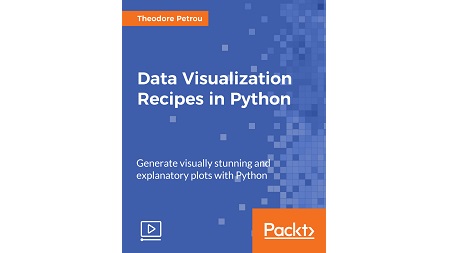
English | MP4 | AVC 1920×1080 | AAC 48KHz 2ch | 1h 43m | 309 MB
Utilize Python’s most efficient libraries—pandas, matplotlib, and Seaborn—for data visualization and time series analysis
Visualization is a critical component in exploratory data analysis, as well as presentations and applications. If you are struggling in your day-to-day data analysis tasks, then this is the right course for you. This fast-pace guide follows a recipe-based approach, each video focusing on a commonly-faced issue.
This course covers advanced and powerful time series capabilities so you can dissect by any possible dimension of time. It introduces the Matplotlib library, which is responsible for all of the plotting in pandas, at the same time focusing on the pandas plot method and the Seaborn library, which is capable of producing aesthetically pleasing visualizations not directly available in pandas. This course guides you, as if you were looking over the shoulder of an expert, through practical situations that you are highly likely to encounter.
The author relies on his vast experience teaching Python in a professional setting to deliver very detailed explanations for each line of code in all of the recipes. All code and dataset explanations reside in Jupyter Notebooks, an excellent interface for exploring data.
What You Will Learn
- Create beautiful and insightful visualizations through pandas’ direct hooks to Matplotlib and Seaborn
- Utilize pandas’ unparalleled time series functionality
- Split data into independent groups before applying aggregations and transformations to each group
- Prepare real-world messy datasets for machine learning
- Combine and merge data from different sources through pandas’ SQL-like operations
Table of Contents
Visualization with Matplotlib and Pandas
1 The Course Overview
2 Getting Started with Matplotlib
3 Visualizing Data with Matplotlib
4 Plotting Basics with Pandas
5 Visualizing the Flights Dataset
Visualization with Seaborn and Pandas
6 Stacking Area Charts to Discover Emerging Trends
7 Understanding the Differences Between Seaborn and Pandas
8 Doing Multivariate Analysis with Seaborn Grids
9 Uncovering Simpson’s Paradox in the Diamonds Dataset with Seaborn
Time Series Analysis
10 Understanding the Difference Between Python and Pandas Date Tools
11 Slicing Time Series Intelligently
12 Using Methods That Only Work with a DatetimeIndex
13 Counting the Number of Weekly Crimes
14 Measuring Crime by Weekday and Year
Grouping and Aggregating with Time Series Analysis
15 Aggregating Weekly Crime and Traffic Accidents Separately
16 Grouping with Anonymous Functions with a DatetimeIndex
17 Grouping By a Timestamp and Another Column
18 Finding the Last Time Crime Was 20% Lower with merge_asof
Resolve the captcha to access the links!